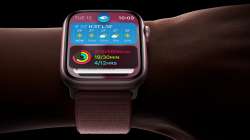Apple Watch Series 9 introduces handy double tap function in watchOS 10.1 Beta
As of now, users can enjoy watchOS 10, which brings a refreshed visual layout for apps, offering quick access to more information, a Smart Stack for timely widget displays, and a collection of charming new watch faces.

Apple enthusiasts have been eagerly awaiting the introduction of the double tap gesture on the freshly launched Apple Watch Series 9. Now, this much-discussed feature is live in the public beta of the watchOS 10.1 software update. While it's not yet accessible to all users, early adopters can now experience the double-tap gesture through the available public beta.
This upcoming free software update, slated for release later this month, promises to revolutionise the way users interact with their Apple Watch Series 9. With the double tap gesture, controlling the device becomes a breeze - all with just one hand and without the need to touch the display.
ALSO READ | ICC Men’s ODI World Cup 2023 starts today: How to watch it for free | Complete guide
To use this feature, users simply tap their index finger and thumb together twice. This action allows for quick and convenient execution of numerous common tasks on the Apple Watch Series 9.
Among its many functions, the double tap serves as a control for the primary button within an app. This means it can be used to pause or start a timer, play or pause music, or even snooze an alarm. Additionally, the gesture can answer or end phone calls and even capture photos using the Camera Remote on the watch. It's worth noting that a double tap also triggers the opening of the Smart Stack on the watch face. Another double tap enables users to seamlessly navigate through widgets in the stack.
ALSO READ | Noise Luna Ring: India's first smart ring for enhanced lifestyle
The success of this new double tap gesture is attributed to the enhanced processing capabilities of the Neural Engine in the Apple Watch Series 9. This powerful component analyses data from the accelerometer, gyroscope, and optical heart sensor using a cutting-edge machine-learning algorithm. The algorithm detects subtle wrist movements and variations in blood flow that occur when the index finger and thumb execute a double tap.
